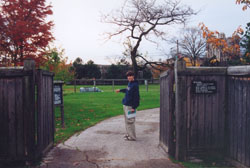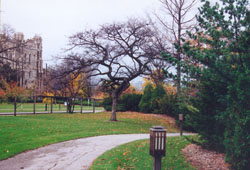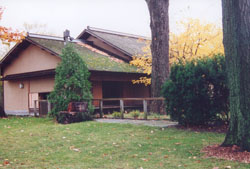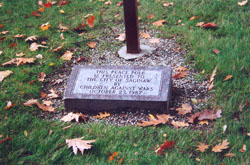
Home
- Artifacts
- Buildings & Businesses
- Churches
- Holidays & Celebrations
- Counties/Locations
- Delta College
- Early Settlers
- Ethnic Background
- Local, Michigan, U.S. and World Events
- Family Genealogy
- Farming
- Libraries & Museums
- Local Sites
- Logging
- Musicians, Artists & Famous People
- Nature, Weather & Four Seasons
- Railroads
- Schools
- Sports
 |
As I sat in my 1987 Chrysler LeBarone with the left blinker on, waiting for oncoming traffic to go by, I was curious about what awaited me. I drove into the parking lot to pay my first visit to the Japanese Garden, which sits on the corner of Ezra Rust Drive and Washington Avenue. I have lived in Saginaw all nineteen years of my life , but had never thought about visiting this unique place before. After passing it endless numbers of times throughout my life, I thought it was about time to catch a glimpse of this Japanese ingredient in Saginaw.
Construction of the Japanese Garden started in 1985 and was finished in 1986. The 1,800 square feet of land was bought in 1978. Saginaw wanted something related to its sister city of Tokushima, Japan, for Saginaw and Tokushima have shared a strong sister city relationship for nearly forty years. The garden is a tribute to the good will between the two cities. The Japanese Garden’s Tea House is one of the few authentic Japanese tea houses in the United States. It was constructed in the traditional manner, using no nails, varnish, or paint of any kind.
 |
As I pulled up to this unexplored destination, I came upon an old weathered wooden fence that stretched around the perimeter of the garden and was about six feet tall. There is a gate through the wooden fence with a sign next to it, detailing the hours the garden is open. As I entered, a cement pathway curved to the right, leading through the garden. Straight ahead I saw fascinating trees straight ahead that grabbed my attention; their branches were tangled and twisted together like God had scribbled them into existence.
Walking down the path there were wooden lampposts spaced out along it. They were about four feet tall with a small wooden pole casing around the lights that sat on top of the posts. I could imagine them glowing along with a red and orange sunset, giving off just enough light to see the path as daylight steadily crept away.
 |
As I went further down the path, there was an assortment of green bushes along the right side of the trail. Some of them had little red berries on them and others did not. Down the trail the bushes curved to the left, jumping over the path and continuing on to the edge of the garden. A little past the bushes was a wooden rectangular bench with no backrest. It sat on the left side of the path. I brushed off the red and yellow leaves that had fallen from the trees and collected on top of it, then proceeded to sit down. Sitting on the hard wooden bench I could feel the cool autumn breeze blowing against my body and could see the leaves stirring on the ground. I was facing the Tea House, looking at a trail made up of square stone tiles that led to the front door. The Tea House has wooden panel walls that still have a healthy fresh-cut wood color to them. The roof, on the other hand, has wooden shingles that are showing the effects of the elements. They have turned dark brown and are beginning to warp. Moss is starting to grow on them, giving a touch of charm.
 |
To my left the path continues. Another path breaks off and leads behind me up to the fence where there is another entrance on Ezra Rust Drive. There is canopy over this entrance that is about fifteen feet tall, and on the top there are shingles that are old and weathered, like those of the Tea House.
The bench was starting to feel quite uncomfortable, so I stood up and started down the trail again. I could hear the cars passing by on Ezra Rust Drive when I noticed a square, dark brown pole that had writing on it. It looked varnished and had plastic covering the writing, which was in a different language on each side. It said, "May Peace Prevail on Earth" in English, Japanese, Spanish, and another language which I couldn't identify.
 |
After passing the pole I came upon a bridge that leads to the edge of the Saginaw River. The railings were bright crimson red and came up to my waist. The bridge curved up and over a little stream that had large rocks that formed its banks. The steam trickled down to the river. The water had turned dark from the leaves that had fallen into it and started to decompose. The air smelled somewhat musty as I walked closer to the river. Next to the river I stood under a square awning that was about seven feet square and ten feet tall. It was held up by four poles that were once blue, but the paint has begun to flake off and has lost the luster it once had. The roof looked the same as the Tea House, but in a bit worse shape. Some of the shingles had begun to fall off. Standing under the canopy I thought I had seen all of the Japanese Garden. I took my time as I walked back to my car, making sure I had not missed anything it has to offer. As I left, I felt pleased that I had finally paid a visit to Saginaw’s Japanese Garden.
It was quite relaxing strolling down the path, seeing the exotic trees and bushes, and standing on the bridge watching the stream flow beneath me. The Japanese Garden is an interesting and pleasant place. Individuals can learn much about the Japanese culture through the tours and classes that are available there. I had an enjoyable time there and am sure any visitor would also.
| The written and visual works in Mid-Michigan Remembers-Stories about Us were chosen on the basis of their quality, diversity, community interest and appeal. Views expressed do not necessarily reflect those of the College. This space is provided as a service by Delta College. |